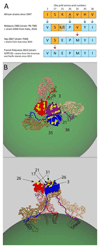Flavivirus structural heterogeneity: implications for cell entry
- PMID: 28683393
- PMCID: PMC6037290
- DOI: 10.1016/j.coviro.2017.06.009
Flavivirus structural heterogeneity: implications for cell entry
Abstract
The explosive spread of Zika virus is the most recent example of the threat imposed to human health by flaviviruses. High-resolution structures are available for several of these arthropod-borne viruses, revealing alternative icosahedral organizations of immature and mature virions. Incomplete proteolytic maturation, however, results in a cloud of highly heterogeneous mosaic particles. This heterogeneity is further expanded by a dynamic behavior of the viral envelope glycoproteins. The ensemble of heterogeneous and dynamic infectious particles circulating in infected hosts offers a range of alternative possible receptor interaction sites at their surfaces, potentially contributing to the broad flavivirus host-range and variation in tissue tropism. The potential synergy between heterogeneous particles in the circulating cloud thus provides an additional dimension to understand the unanticipated properties of Zika virus in its recent outbreaks.
Copyright © 2017 Elsevier B.V. All rights reserved.
Figures



References
-
- Pierson TC, Diamond MS. Flaviviruses. In: Knipe DM, Howley PM, Cohen JI, Griffin DE, Lamb RA, Martin MA, Racaniello VR, Roizman B, editors. Fields virology. Lippincott. Williams & Wilkins; Philadelphia: 2013. pp. 747–794.
Publication types
MeSH terms
Substances
Grants and funding
LinkOut - more resources
Full Text Sources
Other Literature Sources

